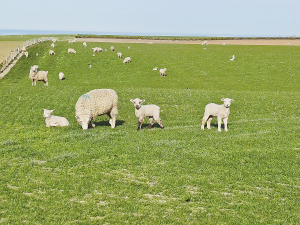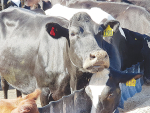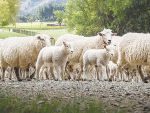Toxoplasmosis is the second most common cause of abortion in sheep.
Toxoplasma gondii has a complicated lifecycle, involving several stages. The three most important of these are the oocyst (egg), the tachyzoite (rapidly multiplying form) and the bradyzoite (slowly multiplying form).
There are two parts to the lifecycle. One, the asexual part of the cycle, takes place in a wide range of warm blooded animals and involves the fast and slow multiplying forms of the parasite (tachyzoites and bradyzoites).
A susceptible animal, which might be a mouse or a sheep, eats food contaminated with toxoplasma eggs. When this happens the toxoplasma parasite penetrates the membrane lining the digestive tract and spreads to the animal’s lymph tissues, where it multiplies.
A second part of the lifecycle, the sexual part, occurs exclusively in cats. When a cat becomes infected by eating infected meat – e.g., a mouse or bird – the cysts in the meat and brain of the mouse or bird dissolve in the stomach of the cat and release the slow multiplying forms of the parasite.
These invade the lining of the cat’s intestine and multiply. Within 10 days, the cat will excrete toxoplasma eggs (oocysts) in its faeces.
An infected cat remains infectious only for about a week, but in this time may shed millions of oocysts every day. As the oocysts are extremely robust and very difficult to destroy, they can remain infective for up to two years. Cats are likely to become infected at quite a young age because of the widespread occurrence of toxoplasma in New Zealand.
Once past their dangerous infective phase, cats will no longer be a source of toxoplasma oocysts.
However, as uncontrolled numbers of feral cats are found on many farms, and the oocysts can persist so long in the farm environment, any cat presence at all is likely to result in a continual source of infection.
Sheep become infected from eating contaminated food (pasture, concentrate feeds, hay etc). Once ingested, the toxoplasma spread to the sheep’s muscles and brain – and also to the placenta.
Shielded from the ewe’s defence system the parasite multiplies rapidly, killing cells as infection spreads. As groups of cells die they give rise to small spots of dead placenta – necrotic foci – which can often be seen with the naked eye. Infection in a pregnant ewe not previously infected by toxoplasma results in loss of the foetus.
However, the time of infection determines the signs evident to the farmer.
- Early pregnancy – early embryonic death; no abortion or visible signs.
- Mid-pregnancy – foetal death and abortion; dead lambs may be found on the ground.
- Late pregnancy – stillborn lambs or weak lambs that fail to thrive.
Ewes that have contracted toxoplasmosis remain infected for life; however they develop ‘immunity’ within about four weeks of first infection.
Field outbreaks caused by infection in mid to late pregnancy will result in affected ewes lambing a few days early.
A large proportion of lambs, although outwardly quite normal, will be stillborn and sometimes accompanied by a ‘mummified’ foetus (a dead, chocolate brown miniature of a lamb).
Twin lambs may be very uneven in size, with one twin smaller and less developed than the other. In addition, a proportion of the lambs born alive will be weak and die within the first few days of life, despite careful nursing.
Diagnosis should be confirmed with laboratory tests on the blood of the lamb and mother. Field outbreaks may also occur caused by infection early in pregnancy.
Trial results throughout New Zealand show that toxoplasmosis abortions early in pregnancy are much more common than previously thought.
The effects are just as damaging to farmers, but are hidden, being evidenced only in the numbers of apparently ‘barren’ ewes
Potential methods to manage the damaging effects of toxoplasmosis include sheep vaccination, drug treatment, and management of cats and sheep.
Toxovax vaccine, effective against toxoplasmosis infection, has been marketed in New Zealand since 1988. As the vaccine is live it has a very short shelf life, so orders have to be placed before you need them.
However, you only need one shot of the vaccine, and it is highly effective in providing long-lasting protection.
Unlike other abortion agents (e.g. campylobacter), toxoplasmosis does not spread directly between sheep, from one ewe to another.
There is therefore no advantage in either isolating ewes from ewes thought to be infected in the hope of avoiding cross-infection, or in placing non-pregnant ewe hoggets or two-tooths where toxoplasma abortions have occurred in the hope of ‘inoculating’ them.



















